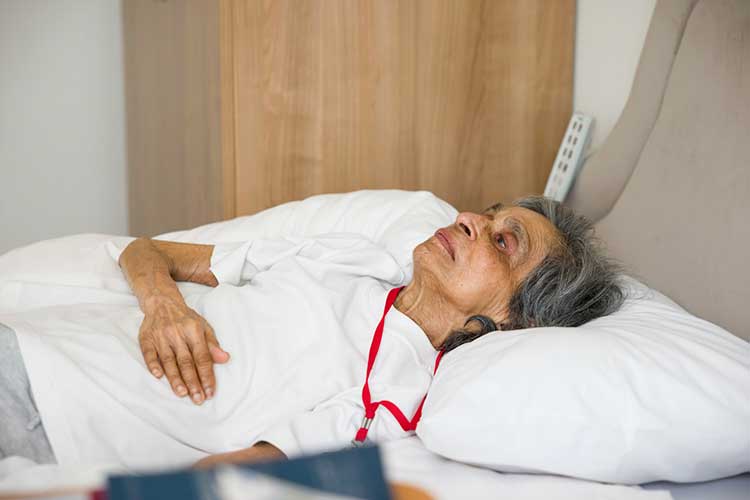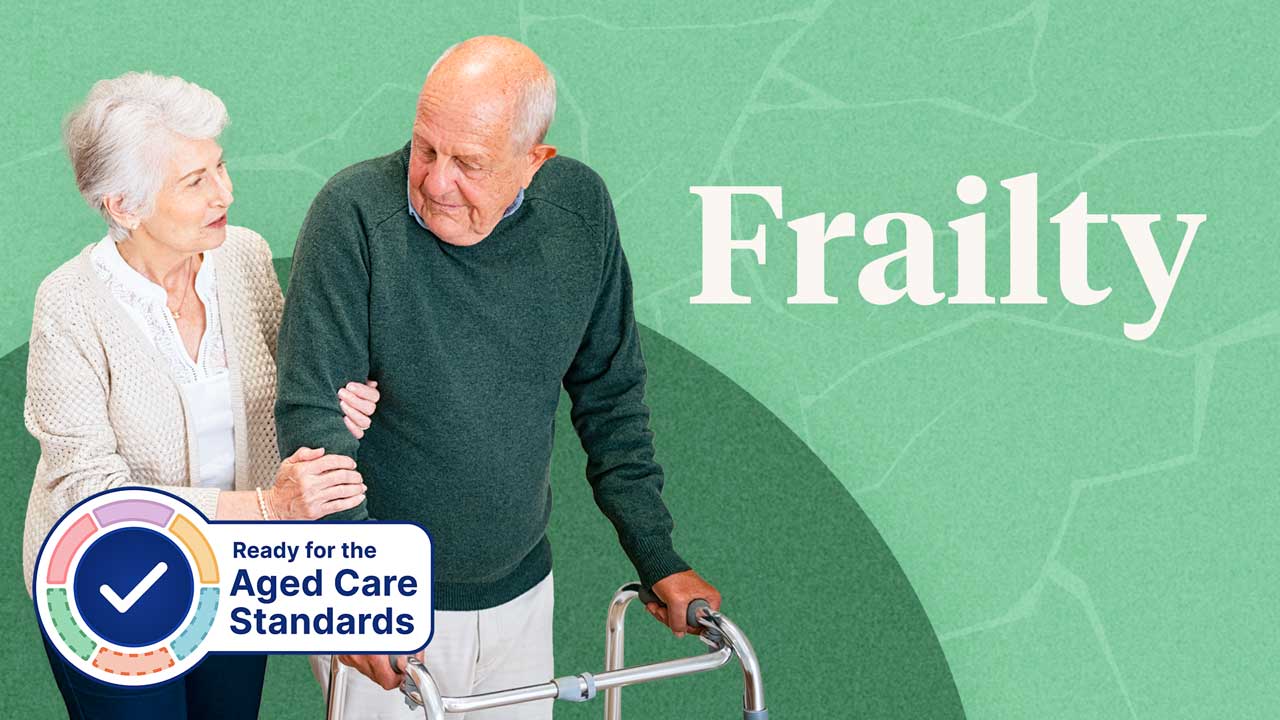The term frailty refers to physiological decline associated with older age (RACGP 2019). People who are frail are among the most vulnerable demographic, with their risk of adverse health outcomes being considerably increased (Walston 2023).
Frailty is a multidimensional state of health that occurs when a person’s physical and cognitive reserves decrease with age, leading to increased vulnerability and reduced resilience to acute illness, trauma and other stressors in comparison to younger and non-frail adults (Health.vic 2021; RACGP 2019).
However, while frailty is associated with the ageing process, frailty is not the same as older age, and it is not an inevitable part of ageing (RACGP 2019).
Assessing Frailty Under the Strengthened Aged Care Quality Standards
Standard 5: Clinical Care - Outcome 5.4: Comprehensive care (Action 5.4.2) of the strengthened Aged Care Quality Standards requires aged care providers to determine an older person’s level of clinical frailty upon initiation of care, when the person’s needs change and at frequent intervals by performing a comprehensive clinical assessment (ACQSC 2024).
What Are the Impacts of Frailty?
Frailty is associated with a variety of adverse effects, including:
- Difficulty coping with stressors such as illness
- Increased risk of falls
- Increased risk of poor health outcomes
- Increased risk of complications during medical procedures
- Increased susceptibility to medication side effects
- Increased risk of requiring residential care
- Increased risk of disability and death
- Longer stays in hospitalc
- Increased recovery time from illness and surgery.
(RACGP 2019; Health.vic 2015a, 2021; QAS 2021)
What Causes Frailty?
Frailty is believed to be associated with dysregulation of the immune, endocrine, stress and energy response systems, which may be caused by age-related molecular changes, genetics and disease (RACGP 2019).
Another contributing factor is age-related changes to hormones and inflammatory pathways, which are associated with sarcopenia (age-related loss of skeletal muscle) (RACGP 2019).
Undernutrition is another key factor involved in frailty, as it results in:
- Decreased muscle strength
- Impaired immune function and wound healing
- Prolonged recovery from illness and surgery
- Decreased psychosocial functioning
- Poor clinical outcomes.
(RACGP 2019)
Risk Factors for Frailty
- Older age (over 65)
- Smoking
- Low level of education
- Post-menopausal therapy
- Being unmarried
- Depression
- Intellectual disability
- Being an Aboriginal and/or Torres Strait Islander person
- Inactive lifestyle
- Undernutrition
- Chronic illness or multimorbidity.
(RACGP 2019; QAS 2021)
What are the Signs of Frailty?

Frailty may or may not have obvious signs. People who are frail might:
- Be excessively fatigued
- Experience unplanned weight loss
- Experience frequent infections
- Fall frequently, have a fear of falling or restrict their activity
- Display cognitive changes
- Have a fluctuating ability to care for themselves that varies from day to day.
(Health.vic 2015a)
Assessing Frailty
While there is no internationally recognised definition of frailty (Mendiratta et al. 2023), below are five of the most referenced frailty screening and assessment tools:
Cardiovascular Health Study (Fried’s Frailty Phenotype Approach)
Fried’s Frailty Phenotype is the most commonly used assessment tool to screen and measure frailty (Health.vic 2015b).
It involves assessing five physiological dimensions of frailty:
- Unplanned weight loss (4 kg or more in the past year)
- Exhaustion
- Low moderate-intensity physical activity
- Muscle weakness (reduced grip strength measured using a dynamometer)
- Slow gait speed.
(Health.vic 2015b; RACGP 2019)
The amount of these problems being experienced by the person determines their score:
| No problems | Robust |
| One or two problems | Pre-frail |
| Three to five problems | Frail |
(ACI 2020)
Clinical Frailty Scale (CFS)
The Clinical Frailty Scale (CFS), developed by Professor Kenneth Rockwood, is a validated screening tool that effectively predicts poor outcomes for older adults in hospital environments (ACI 2020).
The CFS is a nine-point scale ranging from 1 (very fit) to 9 (terminally ill). It’s assessed based on a clinical judgement of the patient’s health two weeks ago (to avoid the influence of acute reversible illness). It includes both a written description and a pictorial representation of each score (ACI 2020; QAS 2021).
| 1. Very fit |
|
| 2. Well |
|
| 3. Managing well |
|
| 4. Vulnerable |
|
| 5. Mildly frail |
|
| 6. Moderately frail |
|
| 7. Severely frail |
|
| 8. Very severely frail |
|
| 9. Terminally ill |
|
(Adapted from Rockwood, cited in QAS 2021)
FRAIL Scale
The FRAIL Scale is a validated questionnaire that uses yes and no answers to assess five dimensions of frailty:
| F - Fatigue | How much of the time during the past four weeks did the person feel tired? |
|
| R - Resistance | In the last four weeks, independently and without mobility aids, has the person had any difficulty walking up 10 steps without resting? |
|
| A - Ambulation | In the last four weeks, independently and without mobility aids, has the person had any difficulty walking for either 300 metres or one block? |
|
| I - Illness | Does the person have any of the following conditions?
|
|
| L - Loss of weight | Has the person lost more than 5 kg or 5% of their body weight in the past year? |
|
(Sydney North Health Network 2018)
The person’s total score should then be added together:
| 0 points | Robust |
| 1 to 2 points | Pre-frail |
| > 3 points | Frail |
(Sydney North Health Network 2018)

Rockwood Mitnitski Frailty Index
The Frailty Index involves assessing the person against a predetermined list of deficits and counting how many of those deficits the person is experiencing (ACI 2020).
The total score is calculated by dividing the number of deficits experienced by the person by the total number of deficits on the list. For example, a person who has 10 deficits out of a list of 40 would have an index of 0.25 (ACI 2020).
| 0 to < 0.1 | Robust |
| 0.1 to < 0.2 | Pre-frail |
| 0.2 to < 0.25 | Approaching frailty |
| > 0.25 | Frail |
(ACI 2020)
Reported Edmonton Frail Scale (REFS)
The Reported Edmonton Frail Scale (REFS) measures the person’s frailty across nine dimensions using both questions and activities:
| 1. Cognition | The person is provided with a pre-drawn circle and asked to pretend it is a clock. They then need to place the numbers in the correct positions, and move the clock hands to show the time ‘ten past eleven’. |
|
| 2. General health | How many times has the person been admitted to the hospital in the past year? |
|
How would the person generally describe their health? |
|
|
| 3. Functional independence | How many of the following activities does the person require help with?
|
|
| 4. Social support | When the person needs help, can they count on someone who is willing and able to help them meet their needs? |
|
| 5. Medication use | Does the person regularly take five or more different prescription medicines? |
|
Does the person ever forget to take their prescription medicines? |
|
|
| 6. Nutrition | Has the person recently lost enough weight to cause their clothing to become looser? |
|
| 7. Mood | Does the person often feel sad or depressed? |
|
| 8. Continence | Does the person lose control of urine when they don’t want to? |
|
| 9. Functional performance | The person should be instructed to sit in a chair with their back and arms resting. When the assessor says 'GO', the person should stand up and walk at a safe and comfortable pace to a mark on the floor about three metres away, then return to the chair and sit down. |
|
(BGS 2018; Alberta Health Services and Covenant Health 2015)
The person’s total score should then be added together:
| 0 to 5 points | Not frail |
| 6 to 7 points | Vulnerable |
| 8 to 9 points | Mild frailty |
| 10 to 11 points | Moderate frailty |
| 12 to 18 points | Severe frailty |
(ACI 2020)
Which Frailty Assessment Tool is Best?
Each frailty assessment tool has pros and cons:
| Tool | Pros | Cons |
|---|---|---|
| Cardiovascular Health Study (Fried’s Frailty Phenotype Approach) |
|
|
| Clinical Frailty Scale |
|
|
| FRAIL Scale |
|
|
| Rockwood Mitnitski Frailty Index |
|
|
| Reported Edmonton Frail Scale |
|
|
(ACI 2020; Health.vic 2015b; RACGP 2019)
Responding to Frailty

Once frailty has been identified, the person typically requires various interventions to address underlying factors such as physical capacity, nutritional status, mental health and cognition. These might include:
- Regular mobilisation
- Improving and maintaining nutrition and hydration
- Supporting and encouraging activities of daily living
- Educating patients, family and carers
- Referring the person to relevant specialists such as physiotherapists, dietitians, speech pathologists, occupational therapists, pharmacists etc.
(Health.vic 2015c)
These interventions will depend on the person and their specific needs.
Test Your Knowledge
Question 1 of 3
A person scores 5 deficits out of 40 on the Rockwood Mitnitski Frailty Index. What is their frailty level?
Topics
References
- Aged Care Quality and Safety Commission 2024, Standard 5: Clinical Care, Australian Government, viewed 26 March 2024, https://www.health.gov.au/resources/publications/strengthened-aged-care-quality-standards-august-2025?language=en
- Agency for Clinical Innovation 2020, Frailty Screening and Assessment Tools, New South Wales Government, viewed 26 March 2024, https://aci.health.nsw.gov.au/networks/frailty-taskforce/resources/frailty-screening-and-assessment-tools
- Alberta Health Services and Covenant Health 2015, Reported Edmonton Frail Scale, Alberta Health Services and Covenant Health, viewed 26 March 2024, https://www.albertahealthservices.ca/assets/about/scn/ahs-scn-bjh-hf-frail-scale.pdf
- British Geriatrics Society 2018, The Edmonton Frail Scale, BGS, viewed 26 March 2024, https://www.bgs.org.uk/sites/default/files/content/attachment/2018-07-05/efs.pdf
- Health.vic 2021, Frailty, Victoria State Government, viewed 26 March 2024, https://www.health.vic.gov.au/patient-care/frailty
- Health.vic 2015a, Frailty and Ageing, Victoria State Government, viewed 26 March 2024, https://www.health.vic.gov.au/patient-care/frailty-and-ageing
- Health.vic 2015b, Identifying Frailty, Victoria State Government, viewed 26 March 2024, https://www.health.vic.gov.au/patient-care/identifying-frailty
- Health.vic 2015c, Responding to Frailty, Victoria State Government, viewed 26 March 2024, https://www.health.vic.gov.au/patient-care/responding-to-frailty
- Mendiratta, P, Schoo, C & Latif, R 2023, ‘Clinical Frailty Scale’, StatPearls, viewed 26 March 2024, https://www.ncbi.nlm.nih.gov/books/NBK559009/
- Queensland Ambulance Service 2021, Clinical Practice Procedures: Assessment/Clinical Frailty Scale, Queensland Government, viewed 26 March 2024, https://www.ambulance.qld.gov.au/docs/clinical/cpp/CPP_Clinical%20frailty%20scale.pdf
- The Royal Australian College of General Practitioners 2019, RACGP Aged Care Clinical Guide (Silver Book) - Silver Book - Part A: Frailty, RACGP, viewed 26 March 2024,https://www.racgp.org.au/clinical-resources/clinical-guidelines/key-racgp-guidelines/view-all-racgp-guidelines/silver-book/part-a/frailty
- Sydney North Health Network 2018, Frail Scale Risk Assessment, Sydney North Health Network, viewed 26 March 2024, https://sydneynorthhealthnetwork.org.au/wp-content/uploads/2018/12/Frail-SNPHN-DL-Brochure_-Frail-scale-5-page-001-700x1524.jpg
- Walston, JD 2023, Frailty, UpToDate, viewed 26 March 2024, https://www.uptodate.com/contents/frailty

